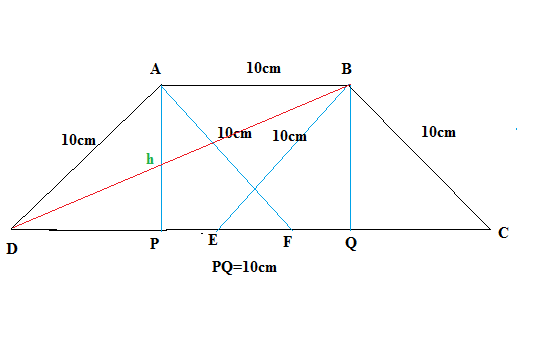Question #8c23f
2 Answers
As below
Explanation:

Given
ABCD is an Isosceles trapezium
Length of its minor base
The diagonal DB bisects
ABCD being an Isosceles trapezium
If we draw a line BE parallel to AD and it intersects DC at E, then quadrilateral ABED will have
and
being two parallel sides of a trapezium.
So ABDE is a parallelogram.
Now by given condition diagonal
DB bisects
Hence
Again
This implies AD=AB=10cm
So ABED must be a rhombus
So BE=AB =BC=10cm=AD=DE
Now
so
ABQP being a rectangle
Area of
Similarly Area of
Area of rectangle
So
Area of the Trapezium
Perimeter of the Trapezium
Angles
Perimeter
Area
Explanation:
Angle
Now
Similarly due to symmetry property of Isosceles trapezium side
Draw
Given
Using Pythagoras theorem
-
#angle D= sin^-1 (3/4)=48.6^@#
As# DC and AB# are#||# and#DA# is transversal,#=>angles A and D# are supplementary angles.
#:. angle A=180-48.6=131.4^@# ,
As the base angles of an isosceles trapezium are equal,#=>angleC=angle D=48.6^@ and angle B=angle A=131.4^@# , all rounded to one decimal place. -
Perimeter of the Isosceles trapezium
#=AB+BC+CF+FE+ED+AD#
#=4xx10+2xx6.61approx53.2cm# - Area of the Isosceles trapezium
#=#
Area of rectangle#AEFB+2xx# Area of#DeltaADE#
(#Deltas ADE and BFC# are congruent)
or Area of the Isosceles trapezium#=10xx7.5+2xx1/2xx6.61xx7.5approx124.6cm^2#

